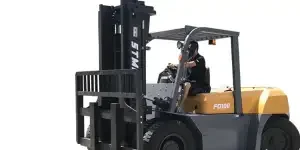Forklift trucks are a very common site at warehouses, trucking and logistics centers. If you need to load or unload crates, pallets, containers or other large items, stack goods, or simply move from one location to another, you’ll want a forklift. There are several different types available on the market, and each has their benefits, but which is right for you? In this article we will aim to answer your questions, so read on for a comprehensive guide to choosing the right forklift.
Table of Contents
The projected growth of the forklift market
What to consider when selecting a forklift
How do the different machines ‘stack up’?
Final thoughts
The projected growth of the forklift market
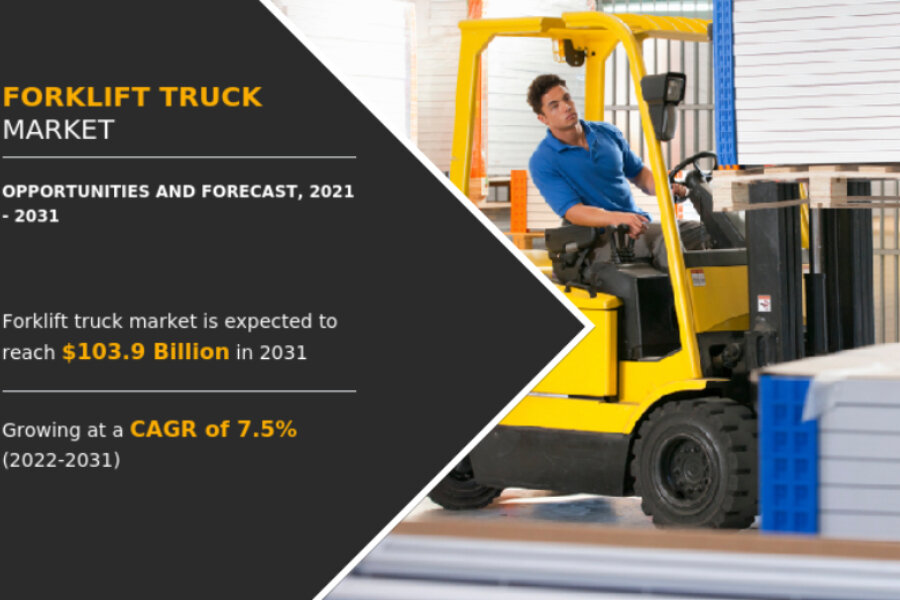
The global forklift market is projected to grow at a CAGR of 7.5% from 2022 to 2031, to reach USD 103.9 billion by 2031. In 2021, electric forklifts generated 66.2% of the global forklift market of USD 51.6 billion, with small size class III forklifts overall exceeding 39% of that value.
E-commerce, with climate-controlled warehousing, is driving the desire for electric powered forklifts, and small storage warehouses with narrow aisles are driving the preference for the smaller sized types.
What to consider when selecting a forklift
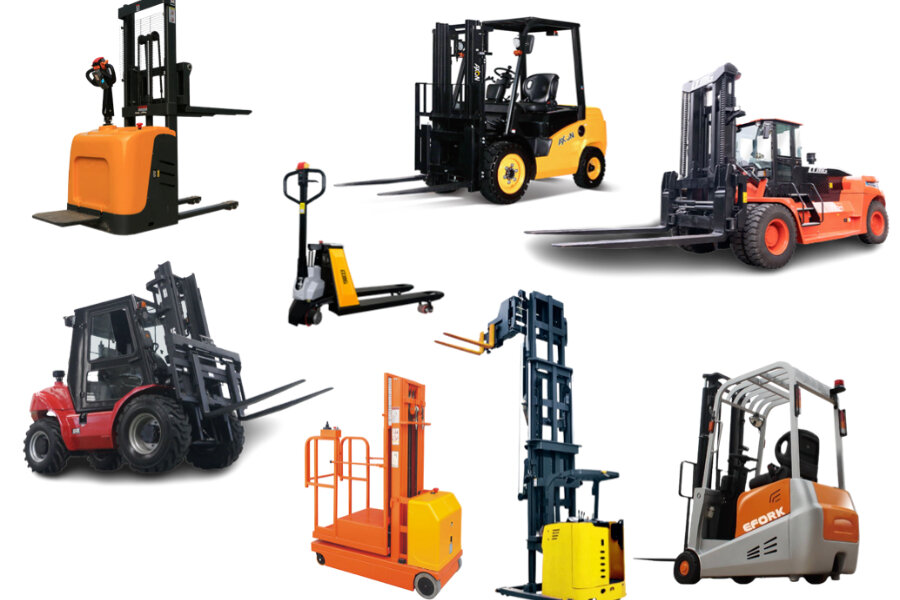
E-commerce fulfillment centers and storage warehouses need inhouse, clean and quiet forklifts with narrow access, or high lift capabilities for product stacking.
The trucking and logistics business is also growing from the e-commerce demand, needing forklifts that can load and unload trucks and containers at warehouses and at destinations. These forklifts may not need such high lift, but are outdoors machines and need to be durable in inclement weather.
Ports and container storage sites need forklifts that are outdoor machines with heavy lifting ability to move full containers, and the construction industry needs robust, all-weather forklifts for general purpose lifting.
Forklifts are defined into classifications, which can be grouped into electric motor, and internal combustion (IC) engine using diesel or gasoline:
- Class I: Electric rider trucks
- Class II: Electric narrow aisle trucks
- Class III: Electric hand or hand/rider trucks
- Class IV: IC engine trucks (solid/cushion tires)
- Class V: IC engine trucks (pneumatic tires)
- Class VII: rough terrain / heavy forklift trucks
(Note: Class VI is for IC engine tractors so they are not included here)
The different types are explained further here:
Electric powered rider forklifts (class I)
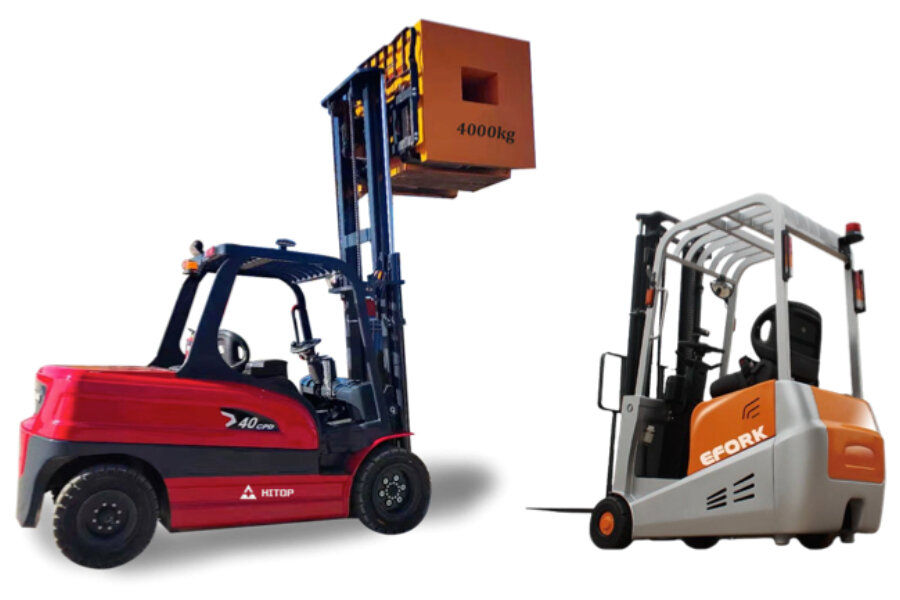
Electric-powered forklifts have battery power ranging from 24-volt and 80-volt, and are clean and quiet with zero emissions. This makes them a good choice for climate controlled warehousing, such as fulfillment centers and food stores. They are also suitable for loading and unloading trucks, handling pallets, and other general warehouse movement.
Electric forklifts come in a wide variety of weight and the bigger machines can handle up to around 8-10 tons loads with stable lifting up to around 6m.
This range of forklift trucks includes counterbalance machines that use the battery as a counterweight to balance the front load and avoid tipping over.
Electric 3-wheeled versions are available, which are popular for their ability to turn in a small radius.
Diesel trucks, Gasoline and LPG trucks (class IV and V)
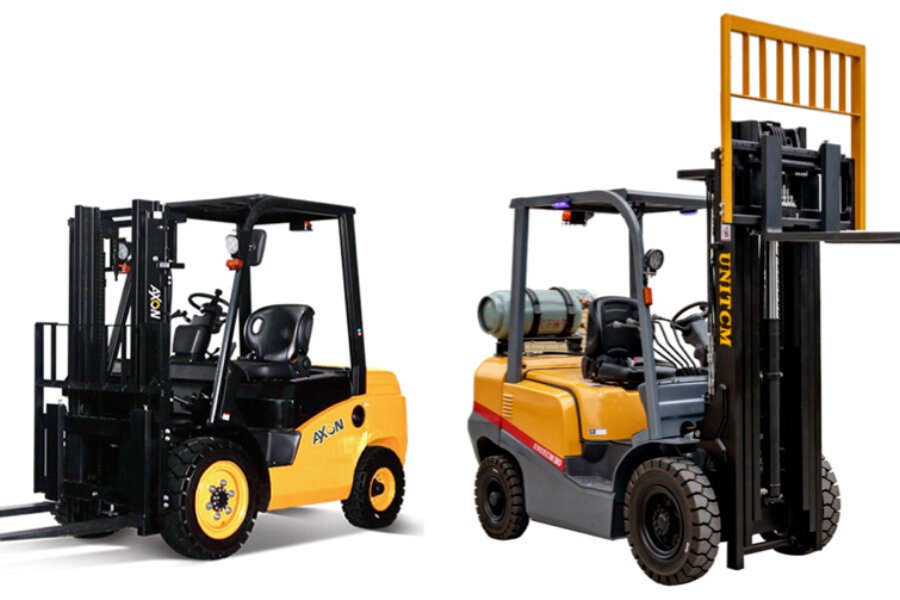
Internal combustion forklift trucks are available in diesel, gasoline and LPG versions. These forklifts all emit exhaust fumes so they are not suitable for indoor closed environments, such as climate-controlled storage. They are a good choice for loading bays, truck and container loading and unloading, and for open-air warehouses and storage. Solid or cushioned tired versions are more commonly used on level warehouse flooring, whereas pneumatic (air-pressure) tired forklifts are used outdoors on more uneven concrete and tarmac sites. Some suppliers can offer different engine and tire options.
Side lift machines (class II, IV and V)
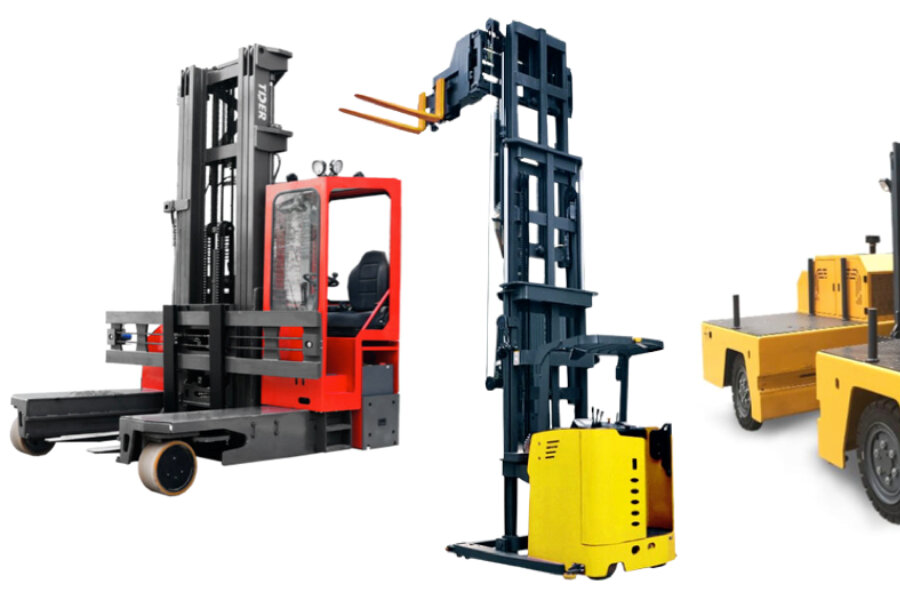
Side lift forklifts are used when there are narrow aisles that don’t permit a front-on approach, and for long items that do not allow turning, such as pipes and steel lengths.
Side lift machines vary from small electric stand-on pallet lifts, electric small rider side lift forklifts, to diesel powered larger heavy duty side lifts. They usually have a standard maximum lift height of around 3m.
Heavy duty, rough terrain forklifts (class VII)
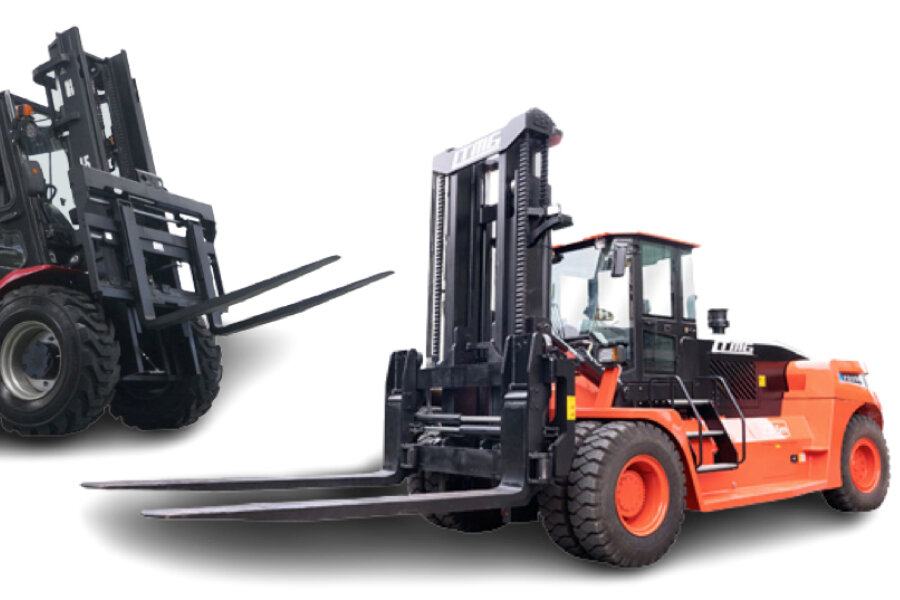
For large and heavy weights, and for rough terrain, there is a range of specialist heavy duty machines that weigh from 4 tons to over 40 tons. Rough terrain forklifts have large deep-tread tires to handle muddy and uneven working, and can lift around 4-5 tons to around 6m. Heavy weight machines include container handlers that can lift over 20 tons up to 6-7m. These are big machines that have long, wide forks, and usually have four front wheels and a heavy counterweight.
Electric pallet jacks, walkie stackers, order pickers, and reach lifts (class II & III)
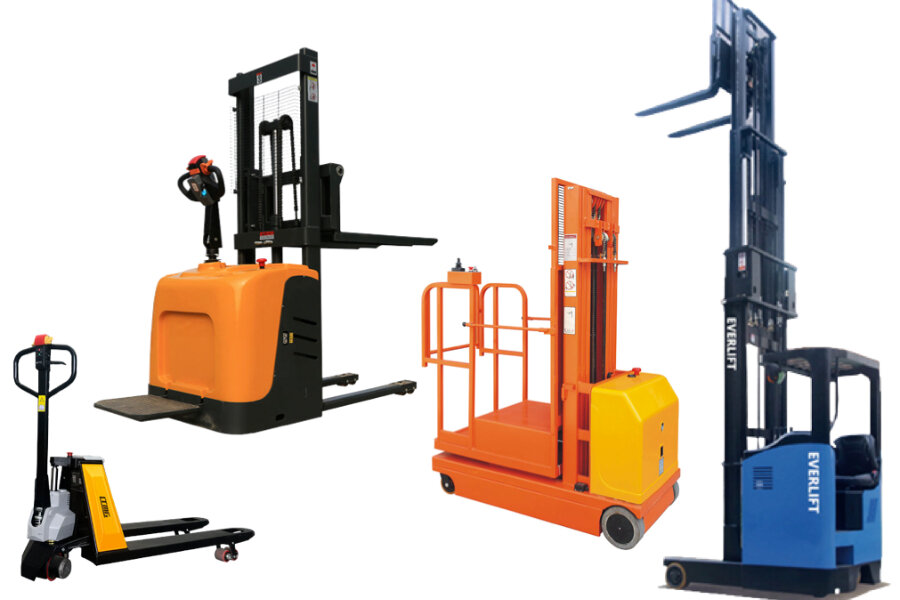
There are a number of different standing and hand operated forklifts within this range, pallet jack, walkie stackers and order pickers and reach lifts.
They are either stand-on or push machines. They are suitable for around 3m racking and for narrow aisle access. These forklifts typically weigh between 0.5 and 2 tons with a maximum lift height of around 3m. They are slow to move around, have small wheels and low clearance and are most suitable for small indoor storage areas with level flooring.
Pallet jacks are electric hand operated, with the operator walking behind the jack. They have low wheels and require a flat floor. They can usually lift up to around 2 tons, to a maximum height of 1.5-2m.
Walkie stackers also have electric motors, with the operator either walking behind, or standing on the rear platform, depending on the model. They can be counterweighted or not. They are hand operated to raise weights of up to 3.5 tons to a height of around 3m.
Order pickers raise the operator, not the products. They can usually raise the operator platform by around 1.5m or even up to 3m. They are intended for the operator to pick small items from high shelving rather than to raise and lower pallets, so their capacity is much lower to around 300-400kg.
Reach, or high-lift, stackers, as their name suggests, extend higher than normal stackers, up to around 5m, to pick and stack on higher racks and storage. Reach stackers are electric driven, and do not rely on the counterweight for balance, although they sometimes have support arms. They must be operated from a stable position on a very level floor.
How do the different machines ‘stack up’?
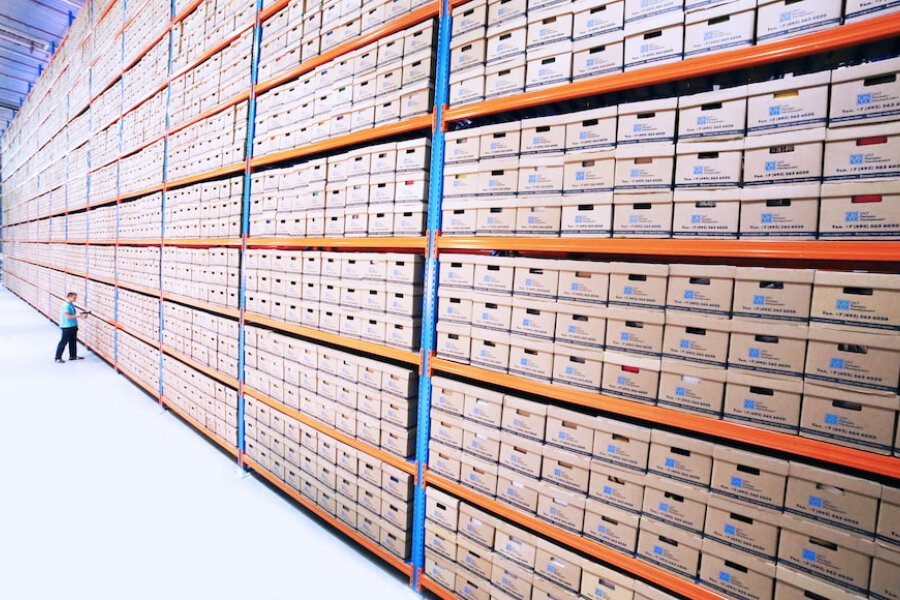
There is a wide range of choices for each product type, and different brands have differing capacities. The following table gives a guide on the typical range and capabilities of the models available, but there are likely to be machines that can exceed these examples under each type.
| Type | Max Weight | Max Lift | Max Height | Usage |
| Pallet Jack | 0.5 ton | 2 ton | 2m | Warehouse |
| Walkie Stackers | 3 ton | 3.5 ton | 3m | Warehouse |
| Order Picker | 0.5 ton | 0.4 ton | 3m | Warehouse |
| Reach Lift | 2 ton | 2 ton | 5m | Warehouse |
| Electric 3 Wheel | 1.5 ton | 1.5 ton | 4m | Warehouse |
| Electric 4 Wheel | 3 ton | 3 ton | 5m | Warehouse |
| Side Lift Pallet | 2 ton | 1,5 ton | 6m | Narrow Aisle |
| Side Lift Rider | 6 ton | 3 ton | 3m | Narrow Aisle |
| Side Lift Diesel | 8 ton | 10 ton | 6m | Open, Aisle |
| Diesel Forklift | 4 ton | 3 ton | 6m | Open Air |
| Gasoline / LPG | 4 ton | 3 ton | 6m | Open Air |
| Rough Terrain | 10 ton | 5 ton | 4.5m | Outdoor |
| Heavy Lift | 25 ton | 18 ton | 5m | Port etc |
Final thoughts
Given the wide range of forklifts available, a buyer should consider the environment, space available and use intended. For indoor fulfillment centers and climate-controlled stores, the first consideration should be electric options, because diesel and gas/LPG powered machines would not be suitable due to their exhaust emissions. For a large warehouse, an electric forklift that can move around quickly and easily would be preferable, which would direct choice to rider machines. However, for smaller stores and narrow aisles, the range of hand-operated pallet lifts and order pickers may be best. A compromise might be the 3 wheel electric rider machines that can turn in a small space. For higher shelving and longer products, the reach lifts or side stackers are options.
For open air warehousing, and for outdoor loading and unloading of trucks and containers, the diesel, gas and LPG options with hard rubber or pneumatic tires, are worth consideration. For more heavy duty tasks, the rough terrain machines may fit, and for the very large container sized lifts, then there are many big machines from which to select.In all cases, a buyer should consider the type of goods that are to be lifted and moved, and match with the maximum load and height capacities that their preferred models can handle. For more information, and to explore the wide range of choices available, check out the Alibaba.com showroom.
